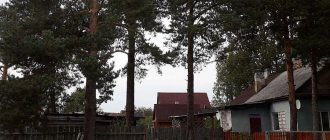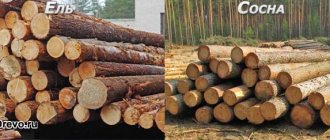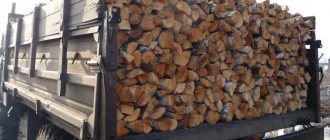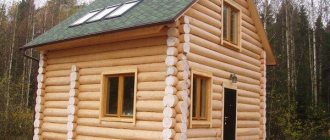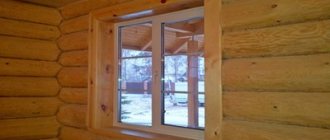- Dimensions of timber for the bath
- How to treat timber
Most often you can find information about birch lining, which is used for lining the inside; linden, pine, cedar, and alder are used for the same purpose; little is written about bathhouses made of birch.
Birch is a specific tree with its own characteristics; this material does not resist rotting as well as we would like. The structure of wood is very dense, so it is extremely difficult to process, especially since it will crack if handled incorrectly. Our ancestors made houses from birch; this wood is dense, like stone, but is not suitable for use in a humid environment. Coniferous species last much longer in such conditions; if the log is thoroughly soaked, there is a chance that the birch material will last longer. Old log houses made of birch showed good results; their walls cannot be taken with a chainsaw!
Properties of birch wood
Birch is diverse, it has about a hundred species , but only two are used in the woodworking industry - pendulous and pubescent. The trunk can be up to a meter thick and up to 40 meters long.
Birch wood is light and coreless. That is, the border between the core and the sapwood is not visible, it is uniform in color. However, there are cases of the formation of a false nucleus, when with age the inner layers change color to a darker color and become light brown.
Construction birch is quite real. That is, there are trees with straight trunks, but what is its use in construction will be discussed further.
The color of the wood varies from light yellow to light brown, with shades of pinkish and reddish (!more about painting here).
Density varies, but the average for dry wood (12% moisture content) is 650 kg per cubic meter. This suggests that the tree is a medium-dense species.
As for hardness, the data is different everywhere, ranging from 3 to 3.6 Brinell units. This is less than that of oak, but much more than that of linden (of which furniture, windows, doors and shelves are best known) and aspen. Iron birch has a higher hardness, but it is rare and is also rarely used and not in construction.
The hardness of birch is one of the essential, often mentioned properties.
They say that old wood is very difficult to cut with tools. IMPORTANT! However, there is also bad news. The resistance of birch wood to rot is lower the more humid the environment it is used in.
From here you can draw a conclusion about the potential of a birch bath. But take your time! Birch lumber rots most quickly where there is contact with water and/or ground. Moreover, we are talking about untreated wood.
Birch. Area. Birch. Genus Betula.
Birch (Betula) is the main genus of the birch family (Betulacease) - dicotyledonous deciduous trees and shrubs. In addition to birch, the family includes 5 more genera: hornbeam, hopshornbeam, alder, hazel and cremastogina. Birch is light-loving, grows successfully in a variety of climatic conditions, is frost-resistant (tolerates permafrost), drought-resistant, and has low demands on soil fertility and moisture. It is found on rocky, poor sandy, loamy, podzolized soils, on drained chernozems, on chestnut and slightly saline, peaty soils. Resistant to gas and smoke. It seems that 120-140 species are usually identified. Different growing conditions cause greater variability in morphological characteristics. They grow in almost all natural areas of the Northern Hemisphere. The largest number of species is in the flora of eastern Asia and North America. Many species are important forest-forming species, being part of mixed forests with other deciduous and coniferous species. Sometimes they form pure high-trunk birch forests, and in the tundra they form shrub and shrub thickets - dwarf birch forests. Birch trees go far to the north and south, in some places to the northern and southern borders of tree vegetation, and rise high into the mountains. In Russia, there are up to 70 species in natural plantings. More than 25 species have been introduced into parks and arboretums. In the European part of Russia, the most common tall-stemmed whitebark birch and downy birch, which largely determine the uniqueness of the landscape of central Russia. Silver birch , warty or weeping birch (Betula pendula) - a tree up to 30 m high (on average 20 m), trunk diameter up to 60-80 cm with an openwork crown, with branches hanging down (hence the name), with snow-white or grayish-white bark, which has different types of fracturing (shape diversity depending on the type of bark). In some forms, a layer of coarse crust forms in the lower part of the trunk. The diamond-cracked form is distinguished by accelerated (more than 2 times) growth; in the rough-barked form, growth is slower, but the wood has a beautiful texture. A characteristic feature of the species is small growths (“warts”) on young shoots. Silver birch has a valuable variety - Karelian birch (Betula pendula var.carelica) and many decorative forms with different types of crown (trapezoidal with especially long weeping branches, etc.). Downy birch (Betula pubes-cens) is a straight-trunked tree with upward spreading branches, smooth white or grayish bark and pubescent young shoots. A valuable variety is burl birch (burl and burl birch). Silver and downy birch have extensive habitats, found in almost all zones, with the exception of the extreme northern, where shrubby birch species grow, and the extreme southern - desert and subtropical. Both species often grow in the same plantings, although they differ in ecological properties. Silver birch prefers drier and higher places. Downy birch tolerates high soil moisture and often grows in heavily moist and even swampy areas. These two species grow together with many deciduous and coniferous species, playing an important role in the succession of coniferous species. They are the first to populate clearings, fires, and wastelands, where they often form pure stands. In Western Siberia, significant areas are occupied by the white-barked large-trunked Krylov birch, which is sometimes identified as an independent species. In Eastern Siberia, birch plantations are more diverse in terms of species (13 species are described). Along with tall-stemmed whitebarks, there are dark-barked, slowly growing forks (woolly birch, Schmidt birch or stone birch, etc.) with very durable wood, which is often called stone. The most common species in Eastern Siberia and the Far East is woolly birch (Betula lantata) tall 15-18 m, up to 50 cm in diameter, forming mountain plantations - stone-birch forests. They often occur after fires in coniferous forests. A significant place in these areas is occupied by the Dahurian or black birch (Betula dahurica) with a height of up to 20 m and a trunk diameter of up to 70 cm, with dark gray or black-brown bark heavily peeling into small plates and very durable wood. It grows in deciduous-coniferous forests. Sometimes the widespread flat-leaved birch (Betula platyphylta) grows in the same planting - a tree up to 20 m high. It is also often found in Transbaikalia and Yakutia. In Eastern Yakutia, the largest habitat is occupied by the white-barked Cayander birch (Betula cajanderi). In the Far East and southern taiga forests, in various altitudinal mountain zones south of the lower reaches of the Amur River, ribbed birch (Betula costata) is found up to 30-35 m high, with shiny light yellow or yellow-brown bark and a trunk ribbed at the butt. In the extreme south of Primorsky Krai, as part of broad-leaved-black-fir mountain forests on dry rocky slopes, one can find Schmidt birch (Betula schmidtii) up to 30 m high with brownish-gray, almost black bark, with very strong heavy wood that sinks in sea water. The Red Book of Russia includes rare species of birch: Schmidt birch, Maksimovich birch (Betula maxi-mowichiana), Radde birch (Betula raddeana), which forms plantations even in treeless mountainous Dagestan.
Log, timber, lining
In this article we are not talking about firewood or crafts made from birch, not about industrial use, but only about the possibility of using it in construction. There are few such possibilities: either to be built from logs/timbers, or to decorate the inside of the bathhouse with birch clapboard.
On sale you can find advertisements for the sale of birch beams or rounded logs, they are inexpensive, you can build from them, but only on the condition that you check the entire batch, because this tree has a strong tendency to warp .
ATTENTION! If birch is dried without a press , then warping will occur. Find out the drying conditions and measure the moisture content of the purchased wood - if you have to dry it at home, then only under pressure.
We said above that there is no need to rush to conclusions. You can very well build from timber or logs, but on the condition that you have very good ventilation , and you make internal thermal insulation , and then line the bathhouse with clapboard made of another tree, more resistant to a humid atmosphere.
Of course, one could say that in dry rooms it is possible to line the walls and ceiling with birch clapboard . But we won’t, because the humidity in the bathhouse always increases during procedures, no matter in what room.
ADVICE! It is birch lining that should not be used in a bathhouse. It's good where it's warm and dry, but it's not about a bathhouse.
Returning to the construction of a log house, in advance of treating the logs or timber with an antiseptic and water-repellent compound. In this case, the bath will last longer. But remember that processing must be resumed from time to time.
We have a lot of materials on processing, we recommend you look at: Choosing what to process boards in a bathhouse, Logs for a bathhouse: which is better and how to process them?, Methods of processing and laying timber in a bathhouse.
In general, there is no categorical ban on construction from birch. But in practice it is used only if there are no other alternatives. Because they understand the characteristics of a given tree and take them into account. The birch ax handle behaves just fine. And a building or a fence...
Conifers
Coniferous trees are not uncommon in Russia, and they have long been considered an inexpensive but high-quality building material. True, the bathhouse has its own specifics; not every tree can withstand its hot steam. The most commonly used coniferous species for sauna logs are spruce, pine and larch.
Pine and spruce
The wood of these species is similar in its properties. It is one of the most affordable and budget-friendly. Spruce and pine logs are quite long, smooth and well processed. When heated in a bathhouse, they give off a resinous pine aroma, which is not only pleasant, but also useful, as it contains natural antibacterial substances - phytoncides.
However, a log house made of spruce or pine has serious disadvantages.
- This wood does not tolerate moisture well - it grows mold and fungi, so the log house requires special treatment with various impregnations;
- Due to the changes that occur in spruce and pine logs under the influence of hot steam, baths made from them are short-lived; You can extend the life of such a structure by constantly treating the logs with special mixtures. Baths that are heated black are more resistant to rotting.
- In the hot air of the bathhouse, coniferous logs begin to “cry” - resin is released from them, which quickly heats up and can cause serious burns. Therefore, it is recommended to line the walls of a bathhouse cut from pine or spruce from the inside with linden or aspen lining.
As you can see, the need for additional investments in impregnation and cladding negates the low cost of the material.
Larch
Compared to spruce and pine, larch wood is more resistant to moisture. Under its influence it only becomes stronger and stronger. In addition, larch contains substances that are natural antiseptics. Therefore, a log house made from this tree is not threatened by either fungus or mold, and a healthy microclimate is created in the bathhouse. The essential oils secreted by larch are good for treating lung and heart diseases.
But a larch frame will cost much more than a spruce or pine one. In addition, this is also a coniferous tree, and also releases resin when heated. True, the walls made of larch logs have been “crying” for about two years. You can be patient.
Yes, there is also cedar. This material is very good, but too expensive. For a bathhouse this is luxury.
Birch bath: pros and cons
In principle, everything is already clear, but it’s worth summarizing what was said above.
The main advantage of birch is its low cost. This is a common tree that is used mainly in the manufacture of plywood; there is little demand for it from private buyers, so it can be purchased cheaply.
Hardness, unfortunately, does not play a special role, and if it does, it will only be to the extent that it will be difficult to process the wood. Therefore, we will classify it as a minus.
But the biggest disadvantage , of course, is its instability to rotting. In essence, the decay of organic matter is either its decomposition with the help of fungi or bacteria. Wood is decomposed by fungi. food, warmth and to reproduce .
There is an abundance of this in the bathhouse, so protection must be carried out in two directions - you need to make the food (wood) tasteless, that is, soak it in an antiseptic, and you need to ensure that dries as quickly as possible after the procedures, that is, think about ventilation, make it forced if necessary.
All that remains is to weigh your circumstances and decide what is more important to you - cheapness or durability of the building. Include in the cost the purchase of antiseptics and water-repellent impregnations (a separate article is devoted to wood with industrial impregnation).
White birch tree under my window. It’s a pity that you can’t build a house from birch (c) Yesenin the Builder
We find out why birch is impractical in house construction.
We find out why birch is impractical in house construction.
Do not consider our small construction modification of the lines of the great Russian poet Sergei Yesenin as blasphemy, but it was hard to resist doing so when mentioning birch in the context of a material for building a wooden house.
After all, this beautiful and even somewhere sacred tree for Russia is well suited for anything - firewood, furniture, plywood, tools, brooms and even sap - but not for the walls of a private house.
Let's figure out why a house (or bathhouse) made of birch in our time is the rarest exotic, despite two seemingly significant factors: 1) the wide distribution of this type of tree in Russia; 2) cheap.
Let’s make a reservation right away: we cannot say that there are no houses/baths made of birch at all. For example, one of the readers of our Zen channel the day before published his opinion in an article about houses made of fir: “houses made of birch stood for 300 years, they need to be felled and chopped in winter, the wood becomes very strong like bone when it dries.”
He is not alone. It turns out that every month about a thousand people are interested in birch houses in the Yandex search engine:
Word service data from Yandex
Word service data from Yandex
But it is still obvious that birch is very inconvenient for construction - namely as a full-fledged material for walls - and in practice it is very difficult to find log houses made entirely or partially from birch. In addition, discussions of birch as a log material are very rare on construction forums on the RuNet.
And there are objective reasons for this:
- fragility - birch is susceptible to rapid decay. The absence of resin, which has a protective function, affects;
- low moisture resistance - very afraid of moisture, like a sponge absorbs moisture. The reality is that often within 4-5 years the log literally turns into dust;
- does not retain heat well - it will be very cool in a birch house;
- Birch logs warp greatly along their length - due to their high dependence on atmospheric influences. Birch has poor resistance to splitting in radial directions; in general, the tree cracks easily;
- a house made of birch takes several times longer to dry out than, for example, one made of pine;
- birch wood is susceptible to attacks by insects, in particular wood-boring beetles;
- high degree of curvature - usually the birch trunk is not as slender as that of coniferous trees, it is more difficult to make a long straight log or board from it;
- birch is hard and at the same time viscous - the density varies from 630 to 680 kg/m3 - this corresponds to a place between medium-heavy and heavy types of wood. Birch is difficult to process; it quickly dulls construction tools. It is more difficult to hammer a nail into a birch than into a pine tree.
It should be noted that birch still plays a role in the construction of wooden houses and bathhouses - it is often used to make dowels - these are special wooden nails that are used to fasten logs together to prevent them from twisting during drying. In addition, birch is sometimes used as a finishing material.
To summarize, it can be noted that birch logs and beams for housing should be used only when no alternative exists.
In Russia, houses are most often built from coniferous trees, or much less often from deciduous trees - oak and aspen.
Previously, we published detailed review reports on the nuances of houses made from various trees. If you missed this, we recommend that you familiarize yourself with the corresponding hyperlinks: a house made of pine, a house made of larch, a house made of cedar, a house made of spruce, a house made of fir, a house made of aspen and, finally, a house made of oak.
Would you dare to build a house or bathhouse from birch? Have you seen birch houses/baths anywhere?
Happy construction!
Like, select “Like” - and then it will be easier for you to follow our new publications, and they come out regularly!
Be sure to click on “Subscribe” if you are planning to buy a wooden house or bathhouse.
Reviews
But there were a lot of reviews about the birch bathhouse online. The overwhelming majority of respondents say that is not suitable for bathhouse construction. They agree that it is possible to build only when there are simply no other options.
As an example of successful construction, they often talk about houses in Northern Kazakhstan, built from birch and withstanding prolonged exposure to precipitation. But they add that there is nothing left to build there.
You can also often find references to the fact that I didn’t build, but someone from a relative there, or from a neighboring village, built a house/bathhouse/garage made of birch, and it has been standing for many years, and this building has not been protected from rain and snow done. Since in this case we are not talking about your own construction, you should treat it with a grain of salt - who knows what the real problems are.
There are also references to the most problematic places - they are under the windows, as well as where there is contact with the ground, but this is more about fences.
We were also interested in the mention of a fungus, against which birch is most defenseless. Its Latin name is unlikely to be needed, but the fact that this mushroom smells like violets is valuable information. If you notice this smell coming from your tree, it's time to look for a quality fungicide.
Hardwood
Not all hardwood is suitable for construction. For example, birch is only suitable for firewood or, in extreme cases, for decorative finishing details. But there are several species that have proven themselves well as a material for a log bathhouse.
Oak
Contrary to popular belief, oak was rarely used in the past for the construction of log houses, and even more so, bathhouses made from it are very rare.
This is, of course, a durable tree that is not afraid of moisture, and a structure made from it will last for centuries. However, oak logs are extremely difficult to process due to the high strength of the wood, and they weigh a lot. Therefore, a heavy oak frame requires a massive foundation.
There is another drawback of oak logs - when drying, they often develop longitudinal cracks.
Well, this material is expensive. Not everyone can afford an oak frame even for their home.
Linden
Linden is considered a popular tree in bathhouse construction. Its wood is light, perfectly processed and fills the hot air of the bathhouse with the aroma of honey. A log house made of linden logs does not require a massive foundation and produces insignificant shrinkage, which is important in construction. However, linden is most often used not for log houses, but for interior wall cladding, for making benches and shelves.
The fact is that the linden log house is short-lived. This wood is susceptible to rotting, fungal attack and quickly deteriorates when exposed to moisture. A sauna made from linden logs requires very careful care - it must be dried and ventilated after each use. Or even replace rotten crowns from time to time.
In addition, linden is an expensive option. The more offensive is the fragility of such a bath.
Aspen
So we got to the main hit of the parade of tree species. Aspen is considered the best tree for baths. It was valued in the old days, and now craftsmen prefer to cut a bathhouse from aspen logs.
- This material, like linden, is well processed, and an aspen frame is quite light, so it does not require a massive foundation.
- When dry, aspen logs do not warp or crack.
- What is most important is that aspen is not afraid of water, and is not as affected by fungi and mold as linden.
- A log house made of aspen logs is strong and durable.
- In terms of price, this is a fairly budget option, especially since such a log house does not require mandatory interior finishing.
